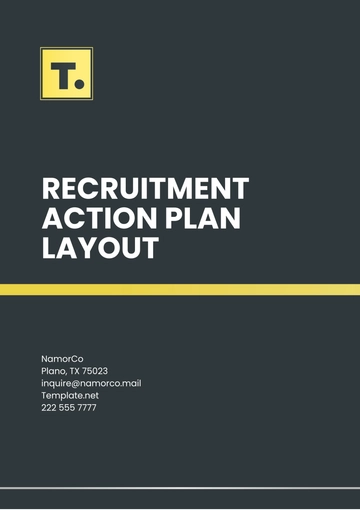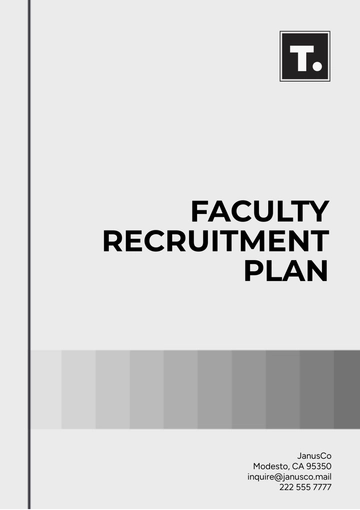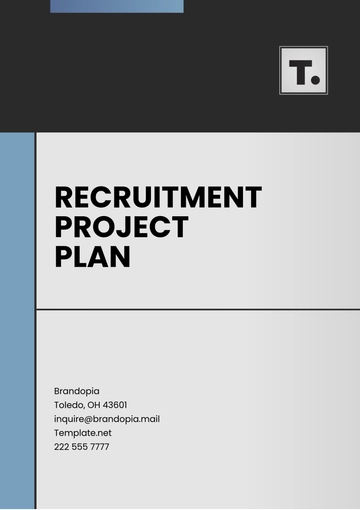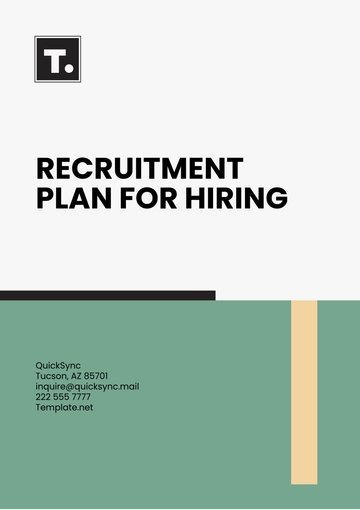Free Personnel Recruitment Plan

Prepared by: [Your Name]
Company Name: [Your Company Name]
Department: Human Resources
Date: [Insert Date]
I. Purpose and Objectives
The purpose of this recruitment plan is to outline a comprehensive approach for attracting, screening, and hiring qualified personnel to meet the staffing needs of [Your Company Name]. The key objectives are:
To ensure recruitment aligns with organizational goals and workforce demands.
To attract high-caliber candidates with diverse skills and backgrounds.
Streamline the hiring process for fairness, efficiency, and compliance.
To build a talent pipeline for future hiring needs.
II. Scope of Recruitment
This plan covers recruitment for the following roles across departments:
Sales and Marketing – Account Executives, Marketing Specialists
Operations – Project Managers, Operations Coordinators
Finance – Financial Analysts, Accountants
Technology – Software Developers, IT Support
Customer Service – Customer Service Representatives, Support Specialists
III. Recruitment Strategies
A. Internal Recruitment
Employee Referrals: Encourage employees to refer qualified candidates by implementing a referral program with incentives.
Job Postings: Post job openings on internal platforms to promote career advancement opportunities.
Skill Development: Identify employees for skill enhancement programs, preparing them for upcoming roles.
B. External Recruitment
Online Job Portals: Use job boards such as LinkedIn, Indeed, and Glassdoor to post openings.
Social Media Recruitment: Share job postings on company social media profiles to reach a broader audience.
University Partnerships: Collaborate with universities and career fairs to attract fresh graduates and interns.
Recruitment Agencies: Partner with agencies for specialized roles requiring niche skills.
IV. Job Analysis and Descriptions
Conduct Job Analysis: Collaborate with department heads to ensure each job role’s requirements are accurate and up-to-date.
Develop Job Descriptions: Outline clear and specific descriptions, including duties, required qualifications, preferred experience, and performance expectations.
V. Candidate Sourcing and Screening
A. Sourcing
Applicant Tracking System (ATS): Use an ATS to organize applications, filter candidates, and streamline communication.
Talent Pipeline: Maintain a database of qualified applicants for future positions.
B. Screening
Initial Screening: Review resumes to match qualifications with job requirements.
Preliminary Interviews: Conduct initial phone or video interviews to assess candidates’ cultural fit and basic qualifications.
Skills Assessment: Implement job-relevant tests, such as technical assessments for IT roles or case studies for analytical roles.
VI. Interview and Selection Process
Structured Interviews: Standardize interview questions across candidates for each role to maintain fairness.
Panel Interviews: Include cross-functional team members in interview panels for diverse perspectives.
Evaluation Rubric: Use a scoring rubric to objectively assess candidates based on key competencies.
VII. Offer and Onboarding
Job Offers: Provide selected candidates with competitive offers, including benefits and career growth opportunities.
Onboarding Program: Establish a structured onboarding process covering orientation, training, and performance objectives for the first 90 days.
VIII. Diversity and Inclusion Initiatives
Inclusive Language: Ensure job descriptions and communications use inclusive language.
Diverse Sourcing Channels: Use channels that reach underrepresented groups to promote workplace diversity.
Unconscious Bias Training: Implement training for hiring managers to minimize biases in selection.
IX. Performance Metrics
To measure the effectiveness of the recruitment plan, the following key performance indicators (KPIs) will be monitored:
Time-to-Fill: Average number of days to fill open positions.
Quality of Hire: Performance and retention of new hires over 12 months.
Offer Acceptance Rate: Percentage of offers accepted by candidates.
Source Effectiveness: Performance of hires from various sources (referrals, job boards, etc.).
X. Budget and Resources
Budget Allocation: Outline costs for job postings, ATS subscriptions, recruitment events, and agency fees.
Resources: Ensure sufficient staffing within the HR department to manage recruitment activities.
XI. Review and Evaluation
Quarterly Review: Assess the effectiveness of recruitment strategies every quarter and adjust the plan as needed.
Continuous Improvement: Gather feedback from new hires and hiring managers to improve recruitment processes.
XII. Conclusion
This recruitment plan provides a clear framework to identify, attract, and hire top talent for [Your Company Name]. By following this structured approach, the HR department will meet organizational goals and strengthen the workforce with skilled, motivated employees.
- 100% Customizable, free editor
- Access 1 Million+ Templates, photo’s & graphics
- Download or share as a template
- Click and replace photos, graphics, text, backgrounds
- Resize, crop, AI write & more
- Access advanced editor
You may also like
- Finance Plan
- Construction Plan
- Sales Plan
- Development Plan
- Career Plan
- Budget Plan
- HR Plan
- Education Plan
- Transition Plan
- Work Plan
- Training Plan
- Communication Plan
- Operation Plan
- Health And Safety Plan
- Strategy Plan
- Professional Development Plan
- Advertising Plan
- Risk Management Plan
- Restaurant Plan
- School Plan
- Nursing Home Patient Care Plan
- Nursing Care Plan
- Plan Event
- Startup Plan
- Social Media Plan
- Staffing Plan
- Annual Plan
- Content Plan
- Payment Plan
- Implementation Plan
- Hotel Plan
- Workout Plan
- Accounting Plan
- Campaign Plan
- Essay Plan
- 30 60 90 Day Plan
- Research Plan
- Recruitment Plan
- 90 Day Plan
- Quarterly Plan
- Emergency Plan
- 5 Year Plan
- Gym Plan
- Personal Plan
- IT and Software Plan
- Treatment Plan
- Real Estate Plan
- Law Firm Plan
- Healthcare Plan
- Improvement Plan
- Media Plan
- 5 Year Business Plan
- Learning Plan
- Marketing Campaign Plan
- Travel Agency Plan
- Cleaning Services Plan
- Interior Design Plan
- Performance Plan
- PR Plan
- Birth Plan
- Life Plan
- SEO Plan
- Disaster Recovery Plan
- Continuity Plan
- Launch Plan
- Legal Plan
- Behavior Plan
- Performance Improvement Plan
- Salon Plan
- Security Plan
- Security Management Plan
- Employee Development Plan
- Quality Plan
- Service Improvement Plan
- Growth Plan
- Incident Response Plan
- Basketball Plan
- Emergency Action Plan
- Product Launch Plan
- Spa Plan
- Employee Training Plan
- Data Analysis Plan
- Employee Action Plan
- Territory Plan
- Audit Plan
- Classroom Plan
- Activity Plan
- Parenting Plan
- Care Plan
- Project Execution Plan
- Exercise Plan
- Internship Plan
- Software Development Plan
- Continuous Improvement Plan
- Leave Plan
- 90 Day Sales Plan
- Advertising Agency Plan
- Employee Transition Plan
- Smart Action Plan
- Workplace Safety Plan
- Behavior Change Plan
- Contingency Plan
- Continuity of Operations Plan
- Health Plan
- Quality Control Plan
- Self Plan
- Sports Development Plan
- Change Management Plan
- Ecommerce Plan
- Personal Financial Plan
- Process Improvement Plan
- 30-60-90 Day Sales Plan
- Crisis Management Plan
- Engagement Plan
- Execution Plan
- Pandemic Plan
- Quality Assurance Plan
- Service Continuity Plan
- Agile Project Plan
- Fundraising Plan
- Job Transition Plan
- Asset Maintenance Plan
- Maintenance Plan
- Software Test Plan
- Staff Training and Development Plan
- 3 Year Plan
- Brand Activation Plan
- Release Plan
- Resource Plan
- Risk Mitigation Plan
- Teacher Plan
- 30 60 90 Day Plan for New Manager
- Food Safety Plan
- Food Truck Plan
- Hiring Plan
- Quality Management Plan
- Wellness Plan
- Behavior Intervention Plan
- Bonus Plan
- Investment Plan
- Maternity Leave Plan
- Pandemic Response Plan
- Succession Planning
- Coaching Plan
- Configuration Management Plan
- Remote Work Plan
- Self Care Plan
- Teaching Plan
- 100-Day Plan
- HACCP Plan
- Student Plan
- Sustainability Plan
- 30 60 90 Day Plan for Interview
- Access Plan
- Site Specific Safety Plan





























